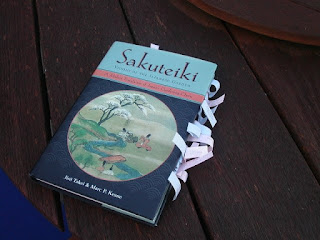 Japanese gardens have been the object of desire in Western culture since the first Iberian sailors set foot on this land. The Japanese art of garden design has a history of about 1300 years. The Zen inspired dry landscapes certainly have a fair reputation, but are not the only nor the first, long before they appeared, Japan was already well developed gardening aesthetics.
Japanese gardens have been the object of desire in Western culture since the first Iberian sailors set foot on this land. The Japanese art of garden design has a history of about 1300 years. The Zen inspired dry landscapes certainly have a fair reputation, but are not the only nor the first, long before they appeared, Japan was already well developed gardening aesthetics. Zen would only add new aesthetic dimensions .

The Sakuteiki is the oldest written that explains how to plan a garden. E t is based on a wealth of practical experience in landscape gardening, although it is already
was practiced earlier in Rome and China. From a careful reading of Sakuteiki, Tachibana Toshituna (1028-1094), shows that the Japanese had mastered the principles of landscape gardening, developing his own style by creating ponds, and small clusters to represent the sea and islands and mounds to represent mountains. . It is based on Feng Shui, universal art of balancing and harmonizing the flow of natural energies in the environment to create beneficial effects on the lives of those who practice it.
Thus, if the objects were arranged in a way that is not correct, was a symbol of bad omen. Shinto, in turn, spread the belief that the world is full of spirits, and that they live on rocks, water plants so that, not to unleash his anger, he had to take extreme care and attention to these elements.
The Japanese considered the world's imagination as you create it. No distinction of self, dreams and madness. The universe is constantly changing, in a continuous process of creation and destruction, life and death. Nothing is static, nothing stays and as the clouds change shape and the stars the sky, and move the mountains and valleys, but too slow to appreciate what the human eye. According to an ancient tradition, two major forces opposite is revealed in this ongoing process, the yin and yang, each pole representing sexual. Each landscape element belongs to one and therefore has a sexual attribute. The ideal landscape is the product of the balance of both.
These gardens, stripped of all luxury, seduced by the clever combination of rocks, shrubs and sand, reflecting the sensitivity of the Japanese and their love of nature. The groove of water that simulates the course of a river is highly appreciated because it brings the garden the feeling of the valley, while the rocks buried to more than half its volume allow for greater naturalness of the mountains.
Thus, Japanese gardens meet the goal of serving as a place of meditation where humans can interpret what he witnesses in his own way, concentrating the energy into your spirit.
In the Western world, attempts to copy this form to create and gardening. However, the mere aesthetic concerns seem to have these replicas do not have at its source: in Japan, easy decoration is shunned, is rooted in religious beliefs and seeks a magical harmony with the environment and natural elements.

The rocks are powerfully symbolic elements, so the choice of stone must be undertaken carefully. Must have artistic forms, but the important thing is to know how to exploit the natural advantages of the chosen rock using, for example, flatter in making waterfalls. Regarding the provision of flowers and plants, there should be plenty of beds and floral motifs. The flower must be a touch of class, because otherwise divert visual appeal. A sober and visually scenic garden is the secret of elegance.
The importance of water
Water is one of the main elements in the oriental gardens, and should give the feeling that flows from the vegetation. The well-known as "sansui" were great gardens that could go boating, sailing the creek water or artificial lakes with islands. The pond was the center of attention, so that the entire garden design revolved around, and although this is not necessarily found in the middle, they occupied a privileged place.

In lakes, it is extremely important place by the penetration of water, usually in a cascade, which should be a point of interest where to focus attention. In addition, can not be entirely desirable from any point of the garden. Waterfalls are one of the characteristics of such gardens, as they introduce the sound and movement in the overall design, complementary to that of the wind in the trees and foliage.
And, of course, also related to water, are the bridges, the most characteristic being constituted by a single slab of stone or of substituting a cheaper material and less noble wood. The islands are also used to create visual interest in other sites. There are also dry gardens, replacing the water through the gravel, marking in these natural forms, simulating streams, etc. The stones that stand in groups are more or less, the islands where the elect rest in peace. Are rocks which are particularly important and fundamental concept is that of balance, balance implicit asymmetric shapes and patterns, the balance between shapes and colors, water and foliage, between empty and full.
Fuentes. Nippon magazine. Text: Tadashi Yokoyama. Japan. The Empire of the Rising Sun. Collcutt, Jansen and Kumakura and Mixmail course.
| |

0 comments:
Post a Comment